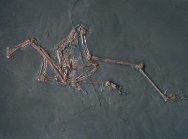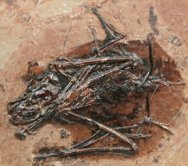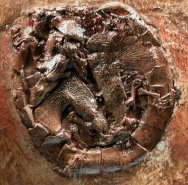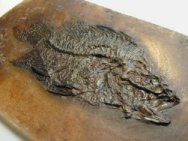Messel
Pit Fossil Fauna and Flora
 The
so called Messel Pit (also called the Messel oil shales) is a
world famous fossil Lagerstätte of Eocene age (about 47
million years ago) that is some 20 miles from Frankfurt, Germany.
The area’s oil shales were actively mined in the 19th century.
The fossils from Messel are extraordinary due to magnificent
preservation,
The
so called Messel Pit (also called the Messel oil shales) is a
world famous fossil Lagerstätte of Eocene age (about 47
million years ago) that is some 20 miles from Frankfurt, Germany.
The area’s oil shales were actively mined in the 19th century.
The fossils from Messel are extraordinary due to magnificent
preservation, including complete articulation and preservation
of soft tissue, even fir, feathers and skin. Stomach contents,
embryos and color have also been found preserved. The fossils
come from water laden sediment, and require special processes
to remove and transport, including embedding them in resin.
including complete articulation and preservation
of soft tissue, even fir, feathers and skin. Stomach contents,
embryos and color have also been found preserved. The fossils
come from water laden sediment, and require special processes
to remove and transport, including embedding them in resin.
Messel
is also an exceptional fossil site due to the diversity of organisms
found, including a wide variety of mammals (e.g., bats, kopidodons
and other rodents, leptictidiums, creodonts, anteaters, tapirs,
hedgehogs, and many more) as well as marsupials and several early
primates. Many bird fossils have been recovered, including early
forms of ostrich, predatory hawks and owls, and other birds related
to hummingbirds and sandpipers. Reptiles are well represented,
including crocodiles, alligators, snakes, salamanders, frogs,
turtles and lizards. Tropical, subtropical and aquatic plants
are found as well as algae and bacterial. Fish and insects dominate
the diverse fauna. The Messel fauna and flora comprise an entire
ecosystem and food chain, are thus of significant scientific
importance (leading to the current designation of the Messel
Oil Shales as a UNESCO World Heritage site in December 1995).
Not surprisingly, only some two per cent of the animals are mammals,
as they would have had to be overcome by toxic gases near the
lake, or when flying over, in the case of birds.
Messel
Oil Shales History and Taphonomy
 The
first fossil discovered was a crocodile in 1975, the consequence
of oil shale mining, but meaningful scientific study did not
begin until the 1970s when falling oil prices caused discontinuation
of mining. For all intents and purposes, amateur fossil collectors
rescued the site from becoming a landfill. Scientists hypothesize
that the “pit” was a deep lake into which surrounding
terrain drained (this seems apparent when viewing the photo of
the area). Slow deposition with high organic content, abundant
dead seaweed and absence of bioturbation resulted in anoxic lake
bottom ideal for preservation. Bacteria may have mediated preservation
of skin tissue morphology by a process known as bacterial mapping,
a taphonomy process prevalent in fine preservation of fish and
insects in the Crato and Santana formations of Brazil. Periodic
algal blooms may have sustained the anoxic and low aerobic bacteria
conditions. Scientists also conjecture that tectonic activity
led to toxic volcanic gas releases, and die offs of animals who
ventured to close to the lake. The lacustrine deposits begin
some 60 meters below the local terrain, and the exposure is only
about a quarter square mile.
The
first fossil discovered was a crocodile in 1975, the consequence
of oil shale mining, but meaningful scientific study did not
begin until the 1970s when falling oil prices caused discontinuation
of mining. For all intents and purposes, amateur fossil collectors
rescued the site from becoming a landfill. Scientists hypothesize
that the “pit” was a deep lake into which surrounding
terrain drained (this seems apparent when viewing the photo of
the area). Slow deposition with high organic content, abundant
dead seaweed and absence of bioturbation resulted in anoxic lake
bottom ideal for preservation. Bacteria may have mediated preservation
of skin tissue morphology by a process known as bacterial mapping,
a taphonomy process prevalent in fine preservation of fish and
insects in the Crato and Santana formations of Brazil. Periodic
algal blooms may have sustained the anoxic and low aerobic bacteria
conditions. Scientists also conjecture that tectonic activity
led to toxic volcanic gas releases, and die offs of animals who
ventured to close to the lake. The lacustrine deposits begin
some 60 meters below the local terrain, and the exposure is only
about a quarter square mile.
Messel
Fossils Preparation
It
was the early amateur collectors who developed the complex process
essential to recover, transport and prepare the Messel fossils.
The fossils were embedded in resin in situ on one side and removed,
transported, stored in damp conditions, and ultimately sealed
in multiple layers of transparent resin, with oil shale removed.
The result is a stunning fossil.


 including complete articulation and preservation
of soft tissue, even fir, feathers and skin. Stomach contents,
embryos and color have also been found preserved. The fossils
come from water laden sediment, and require special processes
to remove and transport, including embedding them in resin.
including complete articulation and preservation
of soft tissue, even fir, feathers and skin. Stomach contents,
embryos and color have also been found preserved. The fossils
come from water laden sediment, and require special processes
to remove and transport, including embedding them in resin. 


